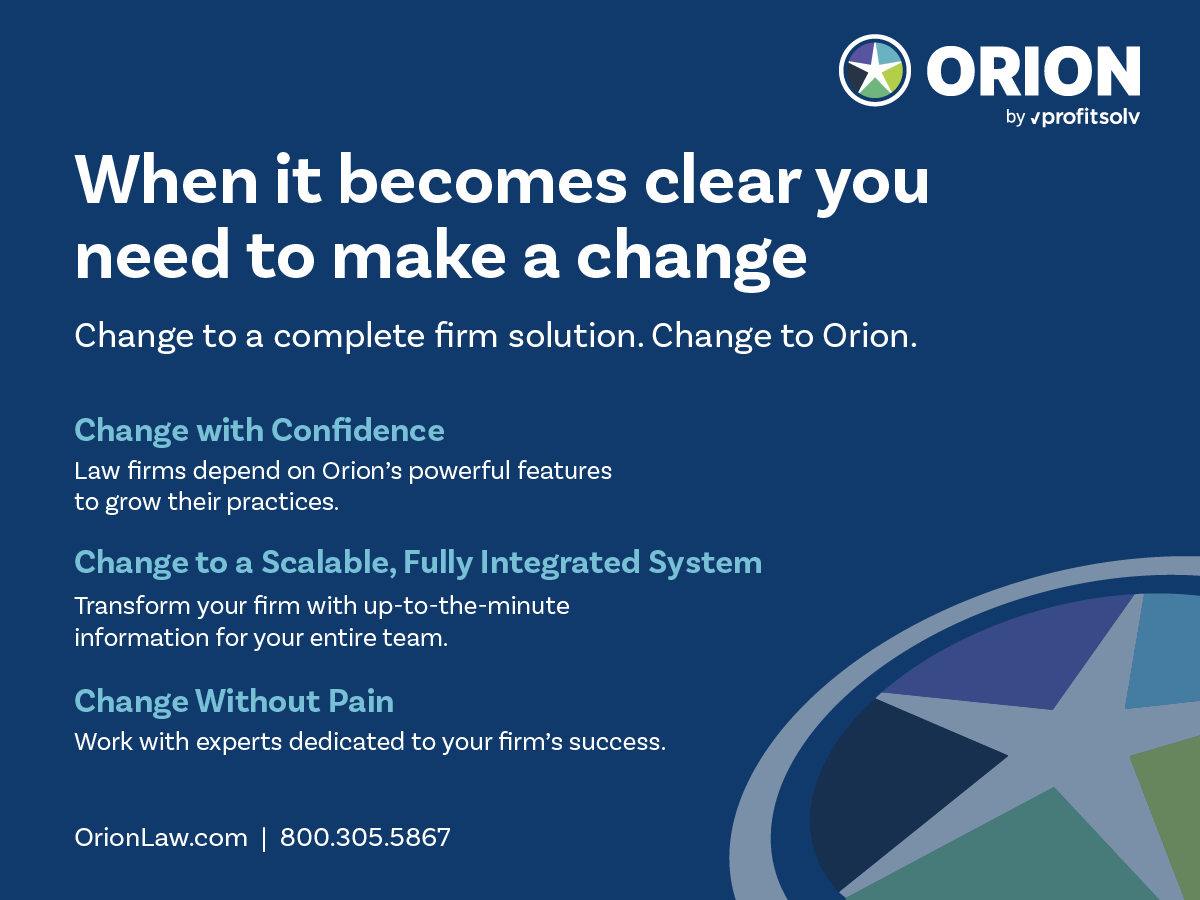Twice as many lawyers who identify as LGBTQ+ worked at law firms in 2022, compared to a decade before; and the percentage of law firm associates who report having a disability more than doubled between 2020 and 2022, according to American Bar Association demographics.
Having a more diverse workforce, however, doesn’t guarantee everyone within a firm will feel welcome and involved.
“A lot ends up being focused on hiring and making sure we've got visual representation we can report to the client — which is not inclusion,” says Judy Hissong, CLM, PCC, President of strategic planning and leadership development service provider Nesso Strategies. “There are lots of very well-meaning, well-intended firms who are really just not [sure about] the best way to go about it.”
Finding out can be key, given the profound impact inclusivity can have on a firm’s culture — which can, in turn, influence retention, productivity and numerous other operational elements.
Culture, for instance, is the top factor law students consider when deciding where to interview and which offer to accept, outranking compensation, advancement opportunities and prestige, according to a report from the non-partisan Yale Law Women+ organization.
ESTABLISHING AN INCLUSIVE STRUCTURE
While a 2023 survey from Above the Law and Major, Lindsey & Africa found the majority of lawyers agree a diverse and inclusive workforce should be a priority for firms, 71% of attorneys of color said they feel law firm culture is inherently biased against diverse attorneys — and nearly 84% of female firm members believe law firm culture is biased against women.
“Inclusivity creates all kinds of innovation and diverse approaches to thought,” Hissong says. “Inclusivity allows all the voices to be heard in the room, which allows us to build the very best firm possible, instead of just the voices that are at the top. There's not going to be innovation without psychological safety.”
Leadership and committee composition can be a visible indication of whether a firm prioritizes inclusivity. Recent research, though, indicates that’s an area where the industry may be falling short.
“Inclusivity allows all the voices to be heard in the room, which allows us to build the very best per firm possible, instead of just the voices that are at the top. There's not going to be innovation without psychological safety.”
White male lawyers comprise the highest percentage of associates and equity and nonequity partners in firms — and are the most likely firm members to serve on compensation and governance committees, according to ABA’s most recent Model Diversity Survey.
As a result, they may play a significant role in inclusivity efforts — whose success tends to depend on the support the initiatives receive from the firm’s highest levels, according to Mauricio Velásquez, MBA, Founder and President of Diversity Training Group.
“Leaders need to lead,” Velásquez says. “Lead by example. Don’t just write a check; hold people accountable. Put metrics in place.”
To foster leadership-based inclusivity within committees, practice and other groups, Hissong suggests thoroughly examining how the firm determines who’ll be in the room when decisions are made.
“Do I have voices from all the ranks, titles that allow different viewpoints to be heard?” she says. “If I'm in charge of a meeting, can I be sure everybody in the room has had opportunity to speak? Which may involve [asking], ‘Hey Judy, we haven't heard from you yet; I know you've got great ideas. What are you thinking?’”
Seeing diverse employees advance can show the firm is committed to inclusion.
“My first partner just got appointed to the bench,” says Amanda DuBois, Founding Partner of DuBois Levias Law Group. “Some of our younger lawyers who are also South Asian aspire to move up in their career like that — and see that how supported [my first partner] Monica was when she was in our office.”
DuBois remembers feeling nervous when, as a relatively new lawyer working at a firm after law school, she’d need to ask a partner a question. The firm expected associates to primarily figure things out on their own; around 6:30 in the evening, its managing partner would roam the office to check who was working late.
“He jingled his keys — you could hear him jingling down the hall and [felt like you should] sit up straight and look busy,” DuBois says. “He would take notes on who was there — that was like leading by intimidation.”
She was determined to create a different type of culture when launching her family law firm. Brand new attorneys spend about a year working closely with a senior lawyer who provides daily guidance, which she feels helps the industry newcomers feel like part of the team.
“Leaders need to lead. Lead by example. Don’t just write a check; hold people accountable. Put metrics in place.”
“That helps build inclusivity because it's not really very hierarchical,” she says. “Everybody flourishes and does their best work when they feel like they matter. The clients are going to be best served if their lawyers feel supported.”
In recent years, the firm has hired a number of formerly incarcerated individuals — unbelievably loyal employees with unique skills, DuBois says, whose needs can sometimes differ from other firm members.
“They've been living under a very oppressive regime,” she says. “If they do something that looks like a mistake, they sort of have [a] trauma response like, ‘I'm going get in really big trouble.’”
In those instances, the firm’s leadership tries to be supportive and understanding — including, DuBois says, “educating the rest of the team that this person might need a little bit of grace.”
“If somebody is late, rather than saying, ‘Why weren't you here on time?’ [we’d say] ‘It happened; how can I support you?’” she says. “There might be an incident in their family — they're concerned they're going to lose their job if they have to leave work to go pick up their kid at school. It's giving people permission to realize that life happens,” DuBois says.
INTERNAL AND EXTERNAL SUPPORT
Diversity, equity and inclusion has been a central tenet at Riley Safer Holmes & Cancila LLP since the national law firm’s founding, according to Managing Partner Patricia Brown Holmes.
Staff members, not just the firm’s litigators, trial and transactional attorneys are invited to social events; the firm’s business casual dress code, Holmes says, allows employees to be authentic in the workplace.
“Inclusion is all about making sure people feel at home and like they belong,” she says. “We call ourselves a family; we encourage people to bring their full selves to work — and that gives us a better product because people can be real.”
The firm also reaches out to ask employees if they’d be willing to help guide its approach in certain instances.
“I actually talk to folks when they first get hired [and say] ‘Hey, will you help us train people — help them understand Asian, [or] Black [or] gay issues?” Holmes says. “We may ask one of our LGBTQ+ folks, ‘Can you take a look at this ad? What would you change?’ — and they say, ‘You may not realize this, but the Pride flag has more colors in it now as a way of highlighting inclusivity and diversity.’ [Employees] don’t have to hide and get to participate; we get to do it the right way.”
RSHC also tries to work with minority-, veteran- and female-owned vendors who provide court reporting, purchasing and other services when possible. The firm has helped some obtain the city of Chicago’s M/WBE certification, Holmes says, designating the business has more than 50% ownership that involves a minority group member or woman, which can allow the vendor to apply for local and other government contracts.
“We've offered several of our vendors pro bono legal services to get them minority-certified,” she says. “It helps them get more work. We've had some who were not incorporated, and we helped them get set up as a legit business. It gives [firm members] a chance to see themselves [in the vendors we work with] — it also gives them a chance to know we're trying to help other people become successful.”
MAINTAINING INCLUSIVITY
Employees’ sense of inclusion, like other aspects of a law firm’s culture, can change over time; checking in periodically to see how firm members feel can help leadership gauge if alterations need to be made.
Employee surveys RSHC has distributed have provided valuable feedback, according to Holmes.
“People have had an opportunity to comment, and then we take into account what those comments might be and try to figure out do we need to do additional programming, or maybe even just do additional explanations?” she says. “Maybe we need some personnel changes. There are a variety of tweaks we make as a result.”
The firm didn’t directly ask how employees felt about diversity, she says.
“Inclusion is all about making sure people feel at home and like they belong .We call ourselves a family; we encourage people to bring their full selves to work — and that gives us a better product because people can be real.”
“We addressed it as, ‘How do you feel about the firm? What things can we do better? What don't you like?’” Holmes says. “The answers to those questions give you what you're looking for. You understand whether somebody feels included if they say something like, ‘I'm never asked to do X, Y and Z.’ They may say something like, ‘We need faster copiers.’ If it really is all about the copy machine, and not about your daily life, then the inclusion part is working.”
Conducting stay interviews — similar to the process some firms use when an employee has accepted a job with another employer but involving people who’ve worked at the firm for some time — is another option, Hissong says. She recommends trying to talk to at least 10% of the firm’s population annually.
“Ask them what they notice, what they think makes this a great firm — and really listen to their answers because some may be exclusion, not inclusion,” Hissong says. “Lots of organizations do exit interviews; the problem is that's too late.”
Firms should aim to resolve any inclusivity issues that arise as quickly as possible, according to Velásquez.
“The best firms have a very clear culture,” he says. “It’s inclusive; it’s welcoming — and if there are issues, they talk about them and put a plan of action in place. Festering long-term issues is what destroys culture and trust.”
While employees may be pleased to hear their firm hopes to provide an inclusive environment, to ensure everyone feels truly welcome and respected, continuity is key.
“Culture, as a concept, is still fairly new in law firms,” Hissong says. “‘We value inclusivity’ might be a stated value — but you need to be living it. The disconnect causes people to leave.”


